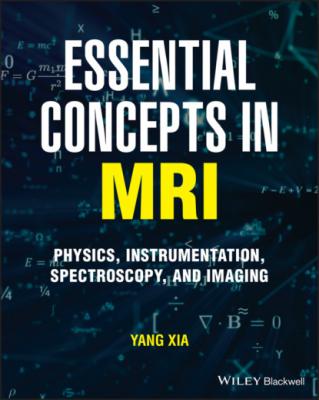Essential Concepts in MRI. Yang Xia
Читать онлайн.| Название | Essential Concepts in MRI |
|---|---|
| Автор произведения | Yang Xia |
| Жанр | Медицина |
| Серия | |
| Издательство | Медицина |
| Год выпуска | 0 |
| isbn | 9781119798248 |
This is the well-known Bloch equation [7]. The first term is due to precessional motion and the second term is due to relaxation. While a precise evaluation of the spin system requires a quantum mechanical treatment, the Bloch equation provides a classical, phenomenological description for liquids and liquid-like systems where the Hamiltonian is of a simple magnetic (vector) form, for example, protons of water molecules in non-viscous liquids and many biological tissues.
Now we are ready to solve the Bloch equation under various conditions. First rewrite the vector equation into the component form, as
The above equations have the usual setup for the magnetic fields as
Thermal equilibrium ensures the initial condition of M in Eq. (2.19) as
Note that as soon as M is tipped away from its thermal equilibrium state, relaxation processes start. In most analyses, however, we consider only one event at a time – that is, when we use the B1 field to tip the magnetization, we do not consider the relaxation of the magnetization during the tipping process.
In order to better examine the solution of the Bloch equation (more precisely, to examine the spectral shapes of the waveform solutions), we will describe the magnetization in a rotating frame with an angular velocity ω about the z axis. In this x′y′z′ frame, we have the component u in the direction of x′ and v in the direction of y′. We can use the common rotation matrix in linear algebra to rewrite the transform matrix as
Note that Eq. (A1.23) is used in this clockwise rotation, which is consistent with the convention specified in Figure 1.3. (For a counterclockwise rotation, keep both terms of v positive and use a minus sign for the second term of u; see Appendix A1.1).
By writing the Bloch equation in this rotating frame and by setting the time derivatives in the equation equal to zero, we can solve the Bloch equation in the rotating frame. The solutions are
2.8 FOURIER TRANSFORM AND SPECTRAL LINE SHAPES
Before we proceed to analyze the characteristics of the magnetization motion expressed in Eq. (2.23), let us pause for a moment to briefly mention two concepts that are essential to modern NMR, Fourier transform (FT) and spectral line shapes.
2.8.1 Fourier Transform
Fourier transform (defined mathematically in Appendix A1.2) utilizes the properties of sine and cosine functions and allows their periods to approach infinity. An operation by FT mathematically decomposes a generic function (often a function of time) into a complex-valued function of frequency, where each frequency can have a certain amplitude. When discussing the FT, one commonly uses the term domain to refer to the “space” where two functions are associated by FT, such as the time-domain function and its frequency domain counterpart. Figure 2.11 shows a sinusoidal oscillation in time and a delta function in frequency as a pair of Fourier functions. Both functions carry the same amount of information, where the frequency (f0) of the delta function is determined by the period (T0) of the oscillation, f0 = 1/T0. One can perform the FT for a multidimensional function (2D, 3D, …); one can also carry out an inverse FT that mathematically restores the original time-domain function from its frequency-domain representation. Table 2.2 lists a few functions and their FT products.
Figure 2.11 Two equivalent functions associated by a Fourier transformation: (a) a sinusoidal oscillation and (b) a delta function. Note that
